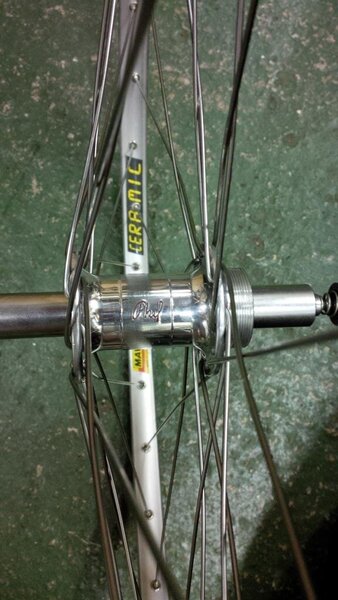Hello to all
I've just built up a pair of wheels for my unicorn ride using a pair of Phil Wood hubs. The front is perfect, but whilst truing the rear, I could feel that there was very minor lateral play of the rim whilst it was in the jig.
Once it was finished, and the wheel was popped into the frame, it was even more prominent. It feels exactly like where the cones on a traditional cone/bearing based hub are just left loose.
Having looked carefully at the hub, I just can't see anyway to adjust them. I'm not sure whether having this issue means that one of the sealed cartridge bearings is duff/knackered (this seems unlikely to me as the hub itself is in superb cosmetic condition and doesn't look as though it's done much in it's life). Also, where the long silver axle spacers that determine the spacing between the dropouts, I can't see how these can be adjusted. They're not like the axle spacers on Bullseye hubs, where they can easily be removed/adjusted by first loosening a very small allen key bolt in each spacer, then adjusted/removed etc - these appear to be a pressure/press fit?
I've given them some "press" together in my beefy old school wheel jig, but this doesn't seem to have any effect. Anyone know how to cure this frustrating problem?
Many thanks
I've just built up a pair of wheels for my unicorn ride using a pair of Phil Wood hubs. The front is perfect, but whilst truing the rear, I could feel that there was very minor lateral play of the rim whilst it was in the jig.
Once it was finished, and the wheel was popped into the frame, it was even more prominent. It feels exactly like where the cones on a traditional cone/bearing based hub are just left loose.
Having looked carefully at the hub, I just can't see anyway to adjust them. I'm not sure whether having this issue means that one of the sealed cartridge bearings is duff/knackered (this seems unlikely to me as the hub itself is in superb cosmetic condition and doesn't look as though it's done much in it's life). Also, where the long silver axle spacers that determine the spacing between the dropouts, I can't see how these can be adjusted. They're not like the axle spacers on Bullseye hubs, where they can easily be removed/adjusted by first loosening a very small allen key bolt in each spacer, then adjusted/removed etc - these appear to be a pressure/press fit?
I've given them some "press" together in my beefy old school wheel jig, but this doesn't seem to have any effect. Anyone know how to cure this frustrating problem?
Many thanks
